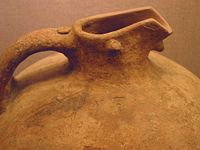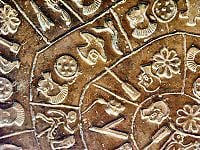Linear A
|
Linear A | ||
|---|---|---|
|
Type |
Undeciphered (likely Syllabic and Ideographic) | |
|
Spoken languages |
'Minoan' (unknown) | |
|
Time period |
Possibly from MM IB to LM IIIA | |
|
ISO 15924 |
Lina | |
| Note: This page may contain IPA phonetic symbols in Unicode. | ||
Linear A is, chronologically, the second of three scripts discovered by archaeologist Sir Arthur Evans while excavating the palace he named Knossos at Crete. Linear A, so named because it is the first of two linear scripts discovered, was used by the Minoan civilization, and dates to 1850-1700 B.C.E. Linear A may have evolved from earlier Cretan hieroglyphs, also discovered at Knossos, although some scholars view the two as coexisting simultaneously. Linear A may have evolved into Linear B, a written language that replaced Linear A around 1450. While Linear B script was deciphered in 1952, most of Linear A remains a mystery.
Discovery
British archaeologist Arthur Evans, inspired by the discoveries of Heinrich Schliemann and ancient Greek mythology, purchased a large piece of land on the island of Crete. He was searching for remains of a civilization ruled by the legendary King Minos, and upon discovering the ruins of the palace at Knossos, he labeled the civilization that inhabited the area "Minoan." While excavating the site in 1900, Evans discovered a number of clay tablets and seals with three distinct forms of writing on them. One form of writing was Cretan Hieroglyphs, a pictographic script that was imprinted predominantly on clay seals. The other two forms, which Evans dubbed "Linear A" and "Linear B," looked to be simplified, linear versions of the hieroglyphic script.
Evans uncovered about 3000 writing tablets containing Linear A and B scripts from the excavations at Knossos. Linear B was deciphered in 1952 by Michael Ventris proving to be an early form of ancient Greek, while Linear A represents the language of the Minoan people before the Mycenaean occupation of the site, a language known as Eteocretan ("True Cretan") that is as yet still undeciphered.[1]
Theories of origin
One of the largest obstacles in the decipherment of Linear A texts is that the ancient Minoan language that it represents is unknown, and may not even belong to a known language family. While Linear A may be similar to other Indo-European languages (particularly Luwian) or Semitic languages, many of these comparisons are speculatory at best. A number of signs are similar to those found in Linear B, but this does not necessarily mean that they are similar in either phonetic value or in meaning. Additionally, the majority of Linear A signs have no link whatsoever with any Linear B sign.[2]
Indo-European/Luwian origin
A popular theory from the 1960s, based on Linear B phonetic values, is that Linear A could be the written form of an Anatolian language, close to Luwian. In 1997, Gareth Alun Owens published a collection of essays entitled Kritika Daidalika, in which he suggested that Linear A might represent an archaic relative of Luwian. Owens based this assertion on the perceived Indo-European but non-Greek roots of a small number of words he was able to read by using the known Linear B sound values of certain Linear A signs. He did not claim a systematic decipherment of Linear A, and remarked in the book that he intended his Luwian hypothesis to provoke discussion, not to settle the issue.
The Luwian origin of Linear A theory, however, lost many supporters over the second half of the twentieth century with the growth of archaeological and linguistic data about Anatolian languages and peoples.
Semitic origin
In 2001, Jan Best published an article claiming to demonstrate how and why Linear A notates an archaic form of Phoenician.[3] This was a continuation of attempts by Cyrus Gordon in finding connections between Minoan and West Semitic languages. His methodology drew widespread criticism. While one or two terms may apparently be of Semitic origin, there is not enough evidence to secure a connection between the language of Linear A and Semitic idioms. Contrary to most other scripts used for Semitic languages, Linear A presents many written vowels.
Indo-Iranian
French scholar Hubert La Marle has suggested that Linear A may belong to the Indo-Iranian family of languages. La Marle based his theory on the frequencies of each sign in certain positions, as well as comparing Linear A to other ancient scripts from around the eastern Mediterranean. La Marle suggested that using these two methods provides conclusions about the phonetic nature of the syllabic signs for a good majority of signs, and that aspects of Linear A closely resemble ancient Indo-Iranian.[4]
Scholars continue to work on the decipherment of Linear A texts, and future discoveries may help to clarify the meaning of the language.
Nature of Linear A artifacts
Linear A texts have been found in numerous locations, from the palace at Knossos to the islands of Thera and Samothrace. The majority of Linear A documents appear to have been used for administrative purposes: labels and clay tablets that record inventory or census information are common. The text on these documents is written in horizontal lines, often using marked registers. Few of these items were discovered in their original locations; fires and earthquakes caused most Linear A artifacts to fall into lower levels.
The largest deposits of Linear A artifacts were found at Agia Triadha, where two buildings contained about 150 tablets and 861 nodules. Excavations at Knossos unearthed 150 Linear A seal impressions and three disks and excavations at Khania yielded 97 clay tablet fragments with lists and censuses, as well as 122 roundels and 28 nodules. Other notable sites include Phaistos, where four flat-based nodules, four roundels, and one sealing on a chest were discovered, as well as the Phaistos disc. Additional items containing Linear A text have been discovered at the sites of Archanes, Gournia, Kea, Melos, Palaikastro, Petras, Platanos, Samothrace, Thera, and Zakros, among others.[5]
Phaistos Disk
One of the most famous Minoan artifacts is the Phaistos Disk, a round clay disk imprinted with symbols that was found in the ancient Minoan city of Phaistos. The disk, which contains a number of pictographic signs arranged in a circular pattern, is thought to date around 1700 B.C.E., making it contemporary with Linear A. While some scholars believe that certain symbols on the disk are similar enough to Linear A or B signs to suggest similar phonetic values, others point out that human figures on the disk are clearly non-Minoan in origin, and that the disk was probably imported. The meaning and purpose of the disk has long been a topic of debate: some have suggested the disk is a poem, a calendar, a sacred text, magical inscription, or a board game. Others have suggested the the disk is a fake, planted by Arthur Evans' rival Luigi Pernier, an Italian archaeologist. According to this theory, Pernier wanted to attract the same attention to the palace at Phaistos that Evans was generating at Knossos, and created an "ancient relic" with untranslatable text to draw interest to his own work.[6]
Notes
- ↑ "Sir Arthur Evans and the Excavation of the Palace at Knossos," Athena Review 3(3) (2003). Retrieved February 6, 2009
- ↑ John Younger, “Linear A Text in Phonetic Transcription” (December 2008) Retrieved February 9, 2009
- ↑ Jan Best, "The First Inscription in Punic — Vowel Differences in Linear A and B," Ugarit-Forschungen, Band 32, Internationales Jahrbuch fur die Altertumskunde Syrien-Palastinas: In memoriam Cyrus H. Gordon Oswald Loretz (ed.) (Ugarit-Verlag, 2001, ISBN 3934628001)
- ↑ Hubert La Marle, "In Search of the Linear A People" (November 1997) Retrieved February 11, 2009.
- ↑ Athena Publications, Inc., “Bronze Age Writing on Crete: Hieroglyphs, Linear A, and Linear B” Athena Review 3(3) (2003): 21. Retrieved February 9, 2009.
- ↑ Dalya Alberge, "Phaistos Disk Declared as Fake by Scholar," TimesOnline, July 12, 2008. Retrieved February 11, 2009.
ReferencesISBN links support NWE through referral fees
- Best, Jan G. P. Some preliminary remarks on the decipherment of Linear A. Las Palmas, Spain: Hakkert, 1972. ISBN 9025606253
- Woodard, Roger D. Greek Writing from Knossos to Homer. New York, NY: Oxford University Press, 1997. ISBN 0195105206
- Campbell-Dunn, Graham. Who were the Minoans? An African Answer. Bloomington, IN: Authorhouse Press, 2006. ISBN 1425920071
- Evans, Arthur. Scripta Minoa: The Written Documents of Minoan Crete, with Special Reference to the Archives of Knossos. Clarendon Press, 1909.
External links
- DAIDALIKA - Scripts and Languages of Minoan and Mycenaean Crete
- Linear A Texts
- Omniglot
- Crete-Minos-Linear A (Hubert La Marle) (French site with certain English links)
Credits
New World Encyclopedia writers and editors rewrote and completed the Wikipedia article in accordance with New World Encyclopedia standards. This article abides by terms of the Creative Commons CC-by-sa 3.0 License (CC-by-sa), which may be used and disseminated with proper attribution. Credit is due under the terms of this license that can reference both the New World Encyclopedia contributors and the selfless volunteer contributors of the Wikimedia Foundation. To cite this article click here for a list of acceptable citing formats.The history of earlier contributions by wikipedians is accessible to researchers here:
The history of this article since it was imported to New World Encyclopedia:
Note: Some restrictions may apply to use of individual images which are separately licensed.





